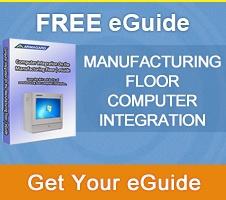
‘To log, track and trace everything’, your vision of a better shop floor. Here’s how you can improve shop floor data collection, long-term.
Have you outgrown your current shop floor data collection system? You’re probably faced with a similar scenario to many growing businesses, your company is expanding quicker than you can implement the systems needed to accommodate your growth.Growth is great, but you’ve quickly come to the conclusion that you need to adapt your data collection systems. This is epecially true if you want to avoid hitting a brick wall that could quite easily stifle your growth, and throw a spanner in the works in terms of taking your business to the next level.
A case study, published by Modern Machine Shop several years ago, caught our eye recently. Although it was published in 2002, the case study highlighted the data collection struggles of a particular company that probably rings true for many SMEs and large corporations alike.
The company featured in the case study found themselves drowning among separate databases, spreadsheets and specialized software programs used to keep track of shipping, scheduling, purchasing, inventory control and job costing.
The problem? Every single piece of data was accessible by the company’s 50+ employees all weighing in with notes and updates on crucial data. There was no coherence and the right hand didn’t know what the left hand was doing. At one point, every program used to record data was being used by no fewer than 21 managers! Imagine the chaos.
A slow process
Worse still, the process of data entry was slow and laborious for all involved, eating into valuable time reserved for production.
Many of the slow process issues stemmed from buying into specialized software programs that staff had to familiarize themselves with and which spread data entry across various databases taking longer for staff to populate the system.
They also made the mistake of sticking to standard computers without equipping them for harsh environment use. Consequently, the tools needed by staff for data input were not positioned at the heart of the production floor.
Instead, data entry computers were positioned in a makeshift office on the other side of the facility to keep them out of harm’s way. For the purposes of improving shop floor data collection and your production process as a whole that’s more than a minor inconvenience for your staff.
Now granted, you might not be in a position where 21 managers and numerous other members of staff are all trying to input data. However, even if there’s only 10 of you, efficiency and coherence are no less important.
Improving shop floor data collection
Shop floor data collection does not require highly sophisticated computer kit and software packages, contrary to what you might be led to believe. Referring back to the earlier case study, you can see how numerous software packages could leave you in a situation similar to a bag of Christmas lights, a lot of crossed wires.
Improving shop floor data collection can be as simple as introducing a touch screen computer system. The highlight of such a product is that it allows you to take a computer system to the central nervous system of your business, the shop floor.
 Introducing an industrial touch screen enclosure system to the shop floor gives staff an efficient way to input essential data.
Introducing an industrial touch screen enclosure system to the shop floor gives staff an efficient way to input essential data.
The added benefit is that you can use your existing equipment to do this. Where’s the advantage in that you ask? You save time and you save money. There’s no outlay for new computer equipment, no disruption for installation and ultimately, minimal downtime.
Additionally, touch screen enclosure systems are beneficial for your staff. How? Using your existing equipment eliminates the need to retrain staff for the use of new systems and software packages.
Alternatively, you can buy a complete solution – enclosure and touch screen combined. You don’t have to shop around to source the necessary kit and staff training requirements are kept to a minimum.
Practically, you remove the need for a keyboard and mouse for data entry. It might only be minutes saved, but over the course of a year those minutes could make all the difference for improving order dispatch times, for instance.
To put touch screens into context for your business, it could be the case that your staff are familiar with touch screen technology. Ask around and you will probably find that the majority of your personnel own a touch screen phone or tablet. Therefore, introducing it to the shop floor won’t upset the balance of your operation.
In contrast, specialized equipment and software packages require you to sacrifice time for installation and staff training. A further downside is that installing such systems makes you reliant on the manufacturer, particularly if the system fails.
It’s often the case that specialist computer systems will require a qualified engineer to fix them in the event of a malfunction. Ultimately, you will find yourself buying into a support service.
The upshot of installing an industrial touch screen enclosure is that you sacrifice less in terms of cash and time, but you gain a system that improves shop floor data collection with minimal disruption and minimal impact on your staff.
If nothing else, staff will welcome the simplification of data entry through touch and overall your business will benefit from timely and accurate data recording that keeps it progressing rather than regressing.
To upgrade your shop floor data collection and improve operational processes for your staff, familiarize yourself with industrial touch screen enclosures today.



